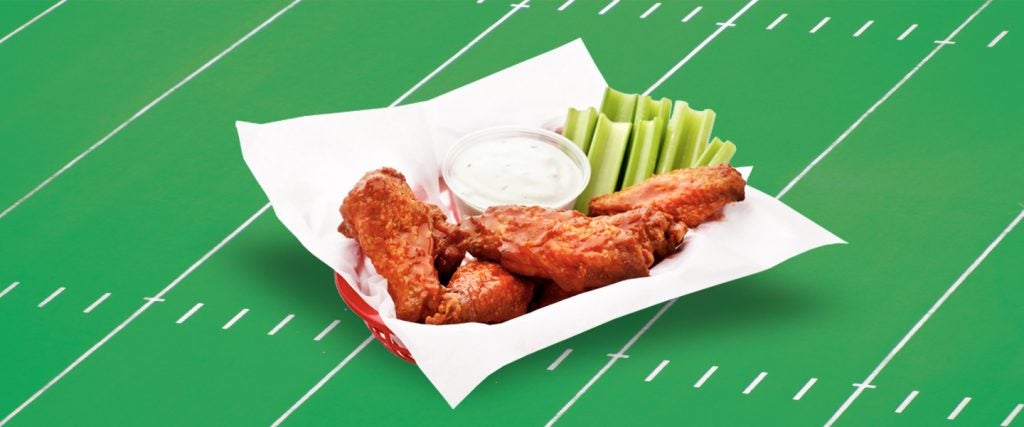Forget Thanksgiving. The most gluttonous day of the year is Super Bowl Sunday, where bowl after bowl and paper plate after paper plate is filled with finger-food bacchanalia that would make even the mad genius responsible for the TGI Friday’s appetizer selection blush (and certainly the ancient Romans). And so, all week leading up to game day, we’ll be offering up our own menu of scientific investigations, origin stories and majestic feats of snacking that not even the biggest sporting event of the year can top. Read all of the stories here.
Is there a greater set of BFFs in the food world than buffalo wings and celery? Sure, there are plenty of iconic food pairings out there — burgers and fries, bacon and eggs, spaghetti and meatballs — but they’re mostly kind of similar in terms of fattiness, healthiness and temperature. The glorious complementary opposite-ness of wings and celery, one a deep-fried fatfest and the other a moist shaft plucked from the earth itself, just makes them that more interesting. Laurel and Hardy wouldn’t have been the same if they were two overweight guys.
Celery coming on a wing plate provides twin functions — cleansing both the palate and the conscience. A bit of vegetable freshness, even coated in bleu cheese, acts as a remise en bouche, but also makes you feel like maybe you’re not just a carnivorous dirtbag shoveling fat down your throat. It’s a vegetable! “It’s also a weight-loss vehicle,” says Drew Cerza, aka “The Wing King,” founder of the National Buffalo Wing Festival. “Celery has no calories. It’s pretty much water, so when you’re chewing it, that’s exercise. Obviously, I haven’t done the math on it.”
Cerza is a fan of a celery accompaniment, although he won’t go as far as to dip the wings themselves. “I’m a purist,” he tells me. “I don’t dip my chicken wings in bleu cheese. That’s like putting A1 on a steak in a high-end restaurant. It’s disrespect to the chef and the wings. I use the bleu cheese and celery to break it up, an intermezzo halfway through.”
But how much of America’s celery is eaten in this way? Don’t ask a celery farmer, they won’t know. What they do know, however, is numerous other uses for celery — it turns out there’s more to it than intra-wing dipping, ants on a log and Bloody Marys.
“Sixty-five percent of our celery crop goes for fresh-food service or retail applications, and 35 percent of the production is processed for soups, salads and juice,” says Gary Wruble, general manager of the Michigan Celery Cooperative. “Our growers also produce high-nitrate celery that’s processed into a natural celery powder for the meat industry as a ‘Clean Label’ ingredient.”
Celery juice is also currently having a bit of a moment, hailed for its myriad health benefits, both genuine and exaggerated. Goop loves it, for instance. And the aforementioned celery powder, due to being high in nitrates but not nitrites, comes under different USDA food-labeling rules to traditionally cured meat.
There might be celery in foods you don’t realize have celery in it as well. “Celery acts as a seasoning in a lot of stocks and soups, often not physically making it into the final dish, but having added flavor earlier in the process,” says Kathleen from Girl & Dug Farm in San Marcos, California. “We grow a celery that’s pink, so a lot of people use ours to garnish dishes, too.”
But other than soups, salads, juice, high-nitrate meat-curing powder, stocks, garnishes, Bloody Marys and ants on a log, it’s basically all wing plates. Right?
Wrong.
“There’s 30 billion wings consumed in the U.S. every year, in three billion servings,” says Cerza, after making several phone calls to industry insiders. That works out to a mean of 90 wings per person per year. However, there are a lot of people who won’t eat any at all (or far less than 90) — there are vegetarians and vegans that will have none, and regions where they’re less popular than others. On the flip side, there are wing aficionados who eat vastly more. Cerza reckons he has 90 per month.
“1.4 billion wings are eaten on Super Bowl Sunday alone,” he says. “There’s one stalk of celery per serving of wings, cut into four. Eighteen billion stalks of celery are grown every year, so if three billion out of 18 billion went to wing plates, that would be 16 percent.”
Job done! But no. “There’s no way it’s 16 percent,” he continues. “That’s way high. That should be in single digits for sure, because that math is based on all the wings going to food service and being served with celery.” What he’s saying is, despite buffalo wings’ huge cultural footprint, especially around the Super Bowl, there are umpteen different ways wings can be prepared — you don’t get celery with wings in Chinese restaurants, for instance, or jerk-style.
As such, Cerza estimates, based on everything he knows, that the real figure could be as low as one percent. And there’s more: “A chicken wing has two parts, a flat and a drumstick, which raises the question, what is 30 billion wings? Is that 30 billion whole wings — the wings of 15 billion chickens — or 30 billion wing parts?”
Jesus Christ. Mysteries on mysteries. One thing’s for sure though — he’s certainly not just winging it.

